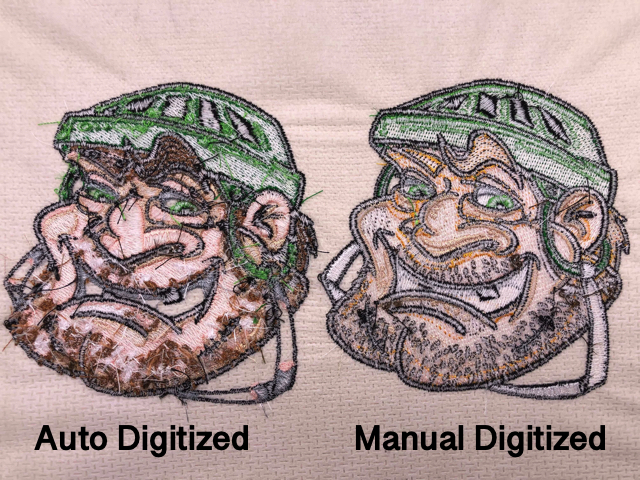Specialist Digitizing for Embroidery: High-Quality Designs
Specialist Digitizing for Embroidery: High-Quality Designs
Blog Article
Understanding the Needlework Digitizing Process: Your Ultimate Guide
Needlework digitizing is a precise craft that requires accuracy and proficiency to translate intricate styles into digital styles for equipment embroidery. As artisans get started on this trip to master the needlework digitizing procedure, a comprehensive understanding of the fundamentals establishes the structure for quality. Beyond the basic understanding exists a world of innovative software, specialized tools, and nuanced methods waiting to be checked out. By diving right into the subtleties of digitizing, one can open a globe of creative possibilities and boost their embroidery projects to new elevations.

Recognizing Needlework Digitizing Fundamentals
Needlework digitizing basics develop the structure whereupon intricate styles are converted into machine-readable styles for exact stitching. This preliminary action in the needlework digitizing procedure is essential for making certain that the last stitched item is a faithful representation of the original design. Understanding embroidery digitizing fundamentals entails grasping vital concepts such as stitch types, stitch instructions, thickness, padding, and draw payment.
Stitch types play a vital duty in establishing the aesthetic and textural result of the embroidered layout. By choosing the suitable stitch type, whether it be satin, fill, or running stitch, digitizers can achieve the wanted impact and enhance the overall top quality of the needlework. Additionally, sew instructions influences the flow and measurement of the style, while density determines the spacing and coverage of the stitches.
Furthermore, underlay sewing offers stability to the layout by protecting the material and avoiding distortion during the needlework procedure. Pull compensation is an additional essential factor to consider to combat the natural propensity of material to contract when stitched. Understanding these needlework digitizing essentials is essential for producing professional-quality stitched products.
Choosing the Right Digitizing Software Program
Picking the suitable digitizing software program is an essential decision that significantly affects the efficiency and top quality of the needlework digitizing process. Digitizing for Embroidery. When selecting the ideal digitizing software, it is vital to consider aspects such as the intricacy of layouts you plan to produce, the user-friendliness of the software program, the level of client assistance supplied, and the compatibility with your embroidery device
There are different digitizing software program alternatives readily available in the market, ranging from fundamental programs for novices to sophisticated software application for expert digitizers. Some preferred selections consist of Wilcom EmbroideryStudio, Hatch Needlework Software, and PulseID. These software provide a large range of tools and features to help you produce complex layouts with convenience.
Prior to choosing, it is recommended to check out the various software program choices with cost-free tests or trials to identify Source which one finest fits your requirements. Furthermore, reviewing reviews and seeking referrals from seasoned digitizers can supply important insights right into the staminas and weaknesses of each software plan (Digitizing for Embroidery). By meticulously examining your requirements and comparing the attributes of various digitizing software application, you can make an informed selection that improves your embroidery digitizing operations
Digitizing Tools and Techniques

Optimizing Style Settings for Embroidery
Mastering the complexities of design settings is fundamental in achieving optimum cause the needlework digitizing procedure, building discover this info here upon the foundation laid by understanding digitizing tools and techniques. When optimizing layout setups for needlework, it is necessary to think about elements such as stitch type, density, padding, draw payment, and registration. Stitch kind option affects the general look of the layout, with alternatives like satin, fill, and running stitches using different structures and effects. Density describes the spacing and density of stitches, impacting the design's protection and resilience. Proper underlay sewing supplies security and stops material distortion, especially for intricate layouts or on stretchy materials. Draw settlement readjusts for material stretch during stitching, making sure exact style replication. Registration settings straighten various aspects of the design accurately, maintaining general design honesty. By fine-tuning these style settings, embroiderers can boost the quality and precision of their stitched creations.

Troubleshooting Common Digitizing Issues
When encountering typical digitizing problems during the needlework process, it is necessary to understand the origin and execute efficient solutions quickly. One usual problem is stitch density problems, where stitches might be too dense, triggering the textile to pucker, or too sporadic, leading to gaps in the style. Readjusting the stitch density settings in the digitizing software application can aid resolve this issue.
One more constant obstacle is thread breaks during the needlework procedure. This can take place due to various factors such as wrong stress settings, dull needles, or utilizing low-quality string. Making certain correct maintenance of the embroidery maker, consisting of normal needle changes and tension adjustments, can reduce the incident of string breaks.
In addition, design registration errors can cause misaligned components within the embroidery style. Examining the layout alignment in the digitizing software application and making needed changes prior to sewing can help in avoiding this issue. By dealing with these typical digitizing problems immediately and effectively, you can make sure a smoother needlework procedure and top notch ended up items.
Verdict
In final thought, grasping the embroidery digitizing process requires a strong understanding of the essentials, the appropriate selection of software program, and knowledge of tools and techniques. Enhancing design settings and troubleshooting common digitizing issues are essential steps in guaranteeing top quality embroidery outcomes. By adhering to these steps vigilantly, one can achieve accuracy and performance in the digitizing process.
Report this page